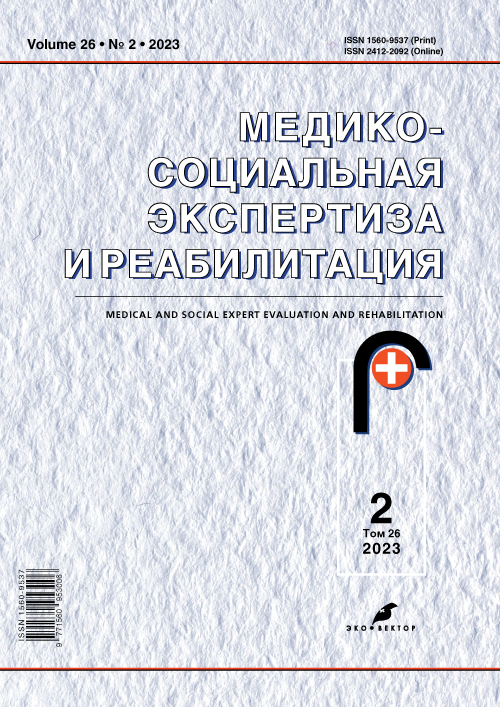Indicators of primary disability in children with mental disorders and autism in St. Petersburg and the Voronezh region
- Authors: Chistyakova N.P.1,2, Litvincev S.V.1, Vladimirova O.N.1
-
Affiliations:
- Federal Scientific and Educational Centre of Medical and Social Expertise and Rehabilitation named after G.A. Albrecht
- Main Bureau of Medical and Social Expertise for Saint Petersburg
- Issue: Vol 26, No 2 (2023)
- Pages: 121-130
- Section: Original study articles
- URL: https://rjmseer.com/1560-9537/article/view/472074
- DOI: https://doi.org/10.17816/MSER472074
- ID: 472074
Cite item
Abstract
BACKGROUND: Mental disorders (including autism) in the Russian Federation rank first among all classes of diseases that form the primary disability in children. Analysis of the state and dynamics of the indicators of primary childhood disability due to this pathology, considering age-specific features, is the basis for further development of medical and social expertise, rehabilitation, and disability prevention.
AIMS: To analyze the state and dynamics of indicators of primary childhood disability caused by mental disorders and autism in St. Petersburg and the Voronezh Oblast.
MATERIALS AND METHODS: The study enrolled children who were recognized to have a disability for the first time caused by mental disorders and autism in St. Petersburg and Voronezh Oblast for 2016–2021. Data sources included statistical collections of the Federal State Statistics Service and forms of state statistical reporting 7-D (sobes). The study is longitudinal and continuous. Analytical, documentary, data copying, statistical, and graphic research methods were employed.
RESULTS: Indicators of primary childhood disability caused by mental disorders and autism are important criteria for the effectiveness of rehabilitation (habilitation) measures. The regional variability and growth of the number and level of IDD among the residents of the Russian Federation was revealed, reaching a maximum in St. Petersburg in 2021 (8.5 per 10 thousand pediatric population) and in the Voronezh region in 2019 (8.2 per 10 thousand pediatric population), which exceeded the all-Russian indicators. The level of autism-related primary childhood disability in 2016–2021 varied in the following ranges: from 0.5 to 0.7 in St. Petersburg (1.4-fold increase), from 2.4 to 1.2 in Voronezh Oblast (2-fold decrease), and from 1.4 to 2.0 per 10,000 children population (1.4-fold increase) in the Russian Federation. The results revealed the dependence of fluctuations in the rates of primary childhood disability caused by mental disorders and autism on changes in the normative legal framework for establishing disability.
CONCLUSION: The data obtained on the regional peculiarities of the dynamics and state of primary childhood disability caused by mental disorders and autism in St. Petersburg and Voronezh Oblast should be used to develop priority directions of medical and social assistance for the prevention of primary childhood disability at the level of regional healthcare organizations.
Full Text
About the authors
Natalia P. Chistyakova
Federal Scientific and Educational Centre of Medical and Social Expertise and Rehabilitation named after G.A. Albrecht; Main Bureau of Medical and Social Expertise for Saint Petersburg
Author for correspondence.
Email: npch74@mail.ru
ORCID iD: 0000-0002-7841-0953
associate professor
Russian Federation, St. Petersburg; St. PetersburgSergej V. Litvincev
Federal Scientific and Educational Centre of Medical and Social Expertise and Rehabilitation named after G.A. Albrecht
Email: sergejlitvincev@yandex.ru
ORCID iD: 0000-0002-1046-287X
md, dr. sci. (med.), professor
Russian Federation, St. PetersburgOksana N. Vladimirova
Federal Scientific and Educational Centre of Medical and Social Expertise and Rehabilitation named after G.A. Albrecht
Email: vladox1204@yandex.ru
ORCID iD: 0000-0001-6692-2882
md, dr. sci. (med.), associate professor
Russian Federation, St. PetersburgReferences
- Verigina NB. Dinamics of Disability in Child Population in the Russian Federation in 2012–2018. Medico-Socialnye problemy invalidnosti. 2019;(3):62–76;112–119 (In Russ).
- Kozlov SI, Verigina NB, Krasnovskaya ES, Asriyan AY. The level of primary child disability in child population in the Russian Federation in dinamics in 2017–2019 (in federal districts and regions). Mediko-sotsial’nye problemy invalidnosti. 2020;(3):8–19 (In Russ).
- Makushkin EV, Demcheva NK. Dynamics and comparative analysis of Child and Adolescent Morbidity of Mental Disorders in the Russian Federation in 2000–2018. Russian Journal of Psychiatry. 2019;(4):4–7. (In Russ). doi: 10.24411/1560-957X-2019-11930
- State and dynamics of disability of the child population of the Russian Federation: Report of the Federal State Budgetary Institution “Federal Bureau of Medical and Social Expertise” of the Ministry of Labor and Social Protection of the Russian Federation. Moscow; 2019. Available from: https://mintrud.gov.ru/ministry/programms/36. Accessed: 07.05.2023. (In Russ).
- Dymochka MA, Shkurko MA, Verigina NB, et al. Dinamics of the level of primary disability due to main types of diseases in child population in the Russian Federation in 2019–2020. Mediko-sotsial’nye problemy invalidnosti. 2021;(3):8–20 (In Russ).
- Dymochka MA, editor. State and Dynamics of Disability, Complex Rehabilitation and Habilitation Disabled adults and children in the Russian Federation: Report of the Federal State Budgetary Institution “Federal Bureau of Medical and Social Expertise” of the Ministry of Labor and Social Protection of the Russian Federation. Moscow; 2021. 436 p. (In Russ.).
- On amendments to the Rules for recognizing a person as a disabled person: Government decree of March 29, 2018 № 339. Collected Legislation of the Russian Federation. 2018;(15):2114. (In Russ).
- Order of the Ministry of Labor of the Russian Federation № 585n of 27 August 2019. “On classifications and criteria used in the implementation of medical and social expertise of citizens by federal state institutions of medical and social expertise”. Available from: https://www.garant.ru/products/ipo/prime/doc/72921006/. Accessed: 06.05.2023. (In Russ).
Supplementary files









